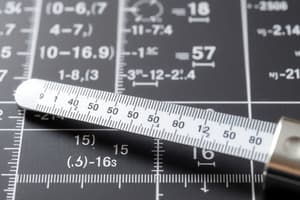Podcast
Questions and Answers
Which quantity can be considered a derived magnitude?
Which quantity can be considered a derived magnitude?
- Temperature
- Time
- Density (correct)
- Length
How can you estimate the surface area of an irregular object?
How can you estimate the surface area of an irregular object?
- By breaking it into smaller regular shapes and summing their areas (correct)
- By measuring the perimeter and applying a geometric formula
- By using a fluid displacement method
- By using a formula for the surface area of a sphere
What is the method for calculating the volume of a cube?
What is the method for calculating the volume of a cube?
- (Length + Width) / 2
- Length x Width x Height (correct)
- Length + Width + Height
- Length x Width
For what type of shapes can you directly apply the formula for volume?
For what type of shapes can you directly apply the formula for volume?
Which derived quantity can be calculated by force applied over an area?
Which derived quantity can be calculated by force applied over an area?
What is the formula used to calculate density?
What is the formula used to calculate density?
Which instrument is primarily used to measure the volume of liquids?
Which instrument is primarily used to measure the volume of liquids?
If a solid object has a mass of 50 grams and occupies a volume of 10 cm³, what is its density?
If a solid object has a mass of 50 grams and occupies a volume of 10 cm³, what is its density?
How is the volume of a gas typically measured in a laboratory setting?
How is the volume of a gas typically measured in a laboratory setting?
What basic quantity is NOT essential for measuring density in objects?
What basic quantity is NOT essential for measuring density in objects?
Flashcards
Derived Quantities
Derived Quantities
Quantities obtained from fundamental quantities.
Surface Area
Surface Area
Space covered by a body in two dimensions (length and width).
Volume
Volume
Space occupied by a body.
Calculating Surface Area (irregular)
Calculating Surface Area (irregular)
Signup and view all the flashcards
Calculating Volume (irregular)
Calculating Volume (irregular)
Signup and view all the flashcards
Density
Density
Signup and view all the flashcards
Measuring Liquid Volume
Measuring Liquid Volume
Signup and view all the flashcards
Measuring Gas Volume
Measuring Gas Volume
Signup and view all the flashcards
Density Formula
Density Formula
Signup and view all the flashcards
Calculating Density
Calculating Density
Signup and view all the flashcards




